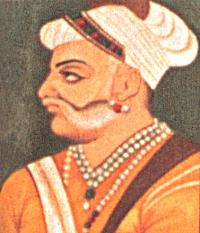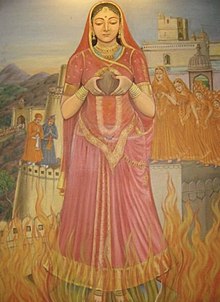
Jauhar, sometimes spelled Jowhar or Juhar, was a Hindu Rajput practice of mass self-immolation by females, both adults and children, in the Indian subcontinent to avoid capture, enslavement and rape by Turko-Persian Islamic invaders when facing certain defeat during a war. Some reports of jauhar mention women committing self-immolation along with their children. This practice was historically observed in the northwest regions of India, with most famous jauhars in recorded history occurring during wars between Hindu Rajput kingdoms in Rajasthan and the opposing Turko-Persian Muslim armies. Jauhar was only performed during war, usually when there was no chance of victory. The term jauhar often connotes jauhar-immolation. Jauhar involved Hindu Rajput women committing suicide with their children and valuables in a massive fire, in order to avoid capture and abuse in the face of inescapable military defeat. At the same time or shortly thereafter, the men would ritualistically march to the battlefield expecting certain death, which in the regional tradition is called saka. This practice was intended to show that those committing it valued their honor more highly than their lives.

Rana Sangram Singh I, popularly known as Rana Sanga was the Maharana of Mewar from 1508 to 1528 CE. Belonging to the Sisodia Rajput dynasty, through his capable leadership, he transformed the Kingdom of Mewar into the most powerful state in northern India in the early 16th century. He controlled parts of present-day Rajasthan, Gujarat and Madhya Pradesh with his capital at Chittor. His reign was admired by several of his contemporaries, including the first Mughal Emperor Babur, who described him as the "greatest Indian ruler" of that time. The Mughal historian Abd al-Qadir Badayuni called Sanga the bravest of all Rajputs. Rana Sanga was the last independent ruler of northern India to control a significant territory before Mughal invasion.

The Sisodia is an Indian Rajput dynasty belonging to the clan that ruled over the Kingdom of Mewar, in the region of Mewar in Rajasthan. The name of the clan is also transliterated as Sesodia, Shishodia, Sishodia, Shishodya, Sisodya, Sisodiya, Sisodia.

Chittorgarh is a major city in the state of Rajasthan in western India. It lies on the Berach River, a tributary of the Banas, and is the administrative headquarters of Chittorgarh District. It was a major stronghold of the Rajput State of Medapata. The city of Chittorgarh is located on the banks of river Gambhiri and Berach.
Raja Shiladitya Tomar, also called Silhadi Tomar, was a chieftain of northeast Malwa in the early decades of 16th century Indian. He become vassal of Sanga of Mewar and remain as an ally and Sanga helped him and Medini Rai in various battles and in conquering Malwa from Sultans. He joined the Rajput Confederacy with garrison of 30,000 Rajputs at the Battle of Khanwa which was fought for supremacy of Northern India between Rajputs and Mughals.

Rao Maldeo Rathore was a king of the Rathore dynasty, who ruled the kingdom of Marwar in present day state of Rajasthan. Maldeo ascended the throne in 1531 CE, inheriting a small ancestral principality of Rathore's but after a long period of military actions against his neighbours, Maldeo swept significant territories which included parts of present day Rajasthan, Haryana, Uttar Pradesh, Gujarat and Sindh. He refused to ally with either the Sur Empire or the Mughal Empire.

The Chittorgarh, also known as Chittod Fort, is one of the largest living forts in India. It is a UNESCO World Heritage Site. The fort was the capital of Mewar and is located in the present-day city of Chittorgarh. It sprawls over a hill 180 m (590.6 ft) in height spread over an area of 280 ha above the plains of the valley drained by the Berach River. The fort covers 65 historic structures, which include four palaces, 19 large temples, 20 large water bodies, 4 memorials and a few victory towers.

Panna Dhai also known as Panna Dai was a 16th-century nursemaid to Udai Singh II, the fourth son of Rana Sanga.

Udai Singh II was the Maharana of Mewar and the founder of the city of Udaipur in the present-day Rajasthan state of India. He was the 12th ruler of the Kingdom of Mewar. He was the fourth son of Rana Sanga and Rani Karnavati, a princess of Bundi.

The Kingdom of Mewar, sometimes known as Udaipur State, was an independent kingdom in Rajputana region of India, ruled by the Sisodia dynasty. It was established around the 6th century by the minor rulers of the Nagada-Ahar region of Udaipur and later, in the 10th century, it transformed into an independent state under Rawal Bharttripatta II.

The siege of Chittorgarh was the military expedition of the Mughal Empire under Akbar against the Mewar kingdom that commenced in 1567 during which the Mughals successfully captured the fort of Chittorgarh after a hard-pressed siege which lasted for several months.
The Mughal–Rajput wars were a series of battles between the Rajput Confederacy and the Mughal Empire. The conflicts originated with the invasion of northwestern India by the Mughal ruler Babur, to which the head of the Rajput confederacy, Rana Sanga, offered staunch resistance.
Hindu Rajput kingdoms in the north-western Indian subcontinent resisted the Muslim invasions of India, beginning with the Umayyad campaigns from the Middle East and the Ghaznavid Turks from Central Asia. They continued resistance against subsequent Muslim empires, including the Arabs, Ghaznavids, Ghurids, Delhi Sultans and the Mughals.
Rana Vikramaditya was the Sisodia Rajput ruler of Mewar Kingdom ,younger son of Rana Sanga and the elder brother of Rana Udai Singh II. He was defeated by the Gujarat Sultanate and was unpopular with the nobles of Mewar. Chittor was sacked by Bahadur Shah of Gujarat in the year 1535 during his reign.

The Battle of Gagron was fought in 1519 between Mahmud Khalji II of Malwa and Rajput Confederacy of Rana Sanga. The conflict took place in Gagron and resulted in Sanga's victory, with him taking Mahmud captive and annexing significant territory.

Rao Ganga or Rav Gango Vaghavat was an Indian king from the Rathore dynasty who ruled the traditional Rathore realm of Maruwara (Marwar) in the present-day state of Rajasthan. Ganga ascended to the throne in 1515 through the support from his family nobles. During his reign, the Rathores consolidated and expanded their rule in Marwar.
Banvir, also known as Banbeer was the ruler of Mewar Kingdom between 1536 and 1540. He was nephew of Rana Sanga, born to his brother Prithviraj and his cocunbine.

The siege of Chittorgarh occurred in 1303, when the Khalji ruler Alauddin Khalji captured and sacked the Chittor Fort, toppling the Guhila king Ratnasimha, after an eight-month-long siege. The conflict has been described in several legendary accounts, including the historical epic poem Padmavat, which claims that Alauddin's motive was to obtain Ratnasimha's beautiful wife Padmini; though this legend is considered historically inaccurate by most historians. Alauddin ordered the fort to be pelted with stones from his siege engines (munjaniqs). When the fort was stormed, Rajput women committed Jauhar while most of the warriors died defending the fort. The city of Chittor was completely sacked by Alauddin's army and several temples were desecrated.
The siege of Chittorgarh took place in 1535, when Sultan Bahadur Shah of Gujarat attacked Chittor Fort, after the death of Rana Sanga, with the aim of expanding his kingdom. The forts defense was led by the Widows of Sanga.











